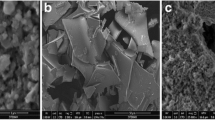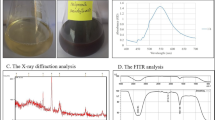Abstract
The present study examines the biogenic preparation of gold nanoparticles using jellyfish Acromitus flagellatus (A. flagellatus) nematocyst venom and their anti-proliferative studies in HEK-293 (normal) and MCF-7 (cancer) cell lines. The nematocyst venom-mediated biogenic prepared gold nanoparticles were characterized using UV–Vis spectroscopy, X-ray diffraction (XRD) and transmission electron microscopy (TEM). TEM micrographs showed that biosynthesized gold nanoparticles possess spherical and triangle morphology with size ranges of about 12–53 and 173–217 nm, respectively. Furthermore, the MTT assay was performed to investigate the anti-proliferative effect of nematocyst venom and nematocyst venom-mediated biogenic gold nanoparticles. The results reported that the nematocyst venom-mediated biogenic gold nanoparticles reduced the cell proliferation in cancer cells MCF-7 with an IC50 of 45.65 μg mL−1 and 18.24 μg mL−1 compared to normal cells (HEK-293) at 48 h. These findings indicated that gold nanoparticles with venom residue exert their anti-proliferative action on the MCF-7 cell line.
Graphical Abstract





Similar content being viewed by others
References
Alekseeva A, Bogatyrev V, Khlebtsov B, Mel’Nikov A, Dykman L, Khlebtsov N (2006) Gold nanorods: Synthesis and optical properties. Colloid J. 68:661–678
Al-Sadoon MK, Rabah DM, Badr G (2013) Enhanced anticancer efficacy of snake venom combined with silica nanoparticles in a murine model of human multiple myeloma: molecular targets for cell cycle arrest and apoptosis induction. Cellular Immunol 284:129–138
Attarde SS, Pandit SV (2020) Anticancer potential of nanogold conjugated toxin GNP-NN-32 from Naja naja venom. J Venom Anim Toxins Incl Trop Dis 26:e20190047
Bagyalakshmi B, Priyadarshini SL, Balamurugan A (2019) Anticancer activity of bee venom against lung cancer cell line (A549 Cells) enhanced by iron oxide nanoparticles synthesized from Syzygium aromaticum. J Drug Deliv Therapeut 9:248–254
Bradford MM (1976) A rapid and sensitive method for the quantitation of microgram quantities of protein utilizing the principle of protein-dye binding. Anal Biochem 72:248–254
Carrette T, Seymour J (2004) A rapid and repeatable method for venom extraction from Cubozoan nematocysts. Toxicon 44:135–139
Chu Z, Zhang S, Zhang B, Zhang C, Fang CY, Rehor I, Cigler P, Chang HC, Lin G, Liu R, Li Q (2014) Unambiguous observation of shape effects on cellular fate of nanoparticles. Sci Rep 4:4495
Enea M, Pereira E, Peixoto de Almeida M, Araújo AM, Bastos MdL, Carmo H (2020) Gold nanoparticles induce oxidative stress and apoptosis in human kidney cells. Nanomaterials 10:995
Fry BG, Vidal N, Norman JA, Vonk FJ, Scheib H, Ramjan SF, Kuruppu S, Fung K, Blair Hedges S, Richardson MK, Hodgson WC, Ignjatovic V, Summerhayes R, Kochva E (2006) Early evolution of the venom system in lizards and snakes. Nature 439:584–588
Govindaraju K, Vasantharaja R, Uma Suganya KS, Anbarasu S, Revathy K, Pugazhendhi A, Karthickeyan D, Singaravelu G (2020) Unveiling the anticancer and antimycobacterial potentials of bioengineered gold nanoparticles. Proc Biochem 96:213–219
Govindaraju K, Uma Suganya KS (2020) In vitro anti-diabetic assessment of guavanoic acid functionalized gold nanoparticles in regulating glucose transport using L6 rat skeletal muscle cells. RSC Med Chem 11:814–822
Joglekar AV, Dehari D, Anjum MM, Dulla N, Chaudhuri A, Singh S, Agrawal AK (2022) Therapeutic potential of venom peptides: insights in the nanoparticle-mediated venom formulations. Futur J Pharm Sci 8:34
Karunarathne KD, de Alwis GWA, de Croos MDST (2021) Live jellyfish-baited small-scale traditional trap fishery operated off the Eastern Coast of Sri Lanka. J Indian Soc Coastal Agricul Res 39:183–194
Kladko DV, Falchevskaya AS, Serov NS, Prilepskii AY (2021) Nanomaterial shape influence on cell behavior. Int J Mol Sci 22:5266
Langille MR, Personick ML, Zhang J, Mirkin CA (2012) Defining rules for the shape evolution of gold nanoparticles. J Am Chem Soc 134:14542–14554
Maduraiveeran H, Arulvasu C, Arulmani A, Shakthi S, Sivaranjani S (2014) Anticancer effect of nematocysts venom from jellyfish Acromitus Flagellatus, on human breast cancer cell line. World J Pharm Res 3:1130–1145
Mody VV, Siwale R, Singh A, Mody HR (2010) Introduction to metallic nanoparticles. J Pharm Bioallied Sci 2:282–289
Morgan E, Wupperfeld D, Morales D, Reich N (2019) Shape matters: gold nanoparticle shape impacts the biological activity of siRNA delivery. Bioconjugate Chem 30:853–860
Mostafa M, Das DB, Salem ZA, Beherei HH (2021) Nanomaterials for biomedical applications: Production, characterisations, recent trends and difficulties. Molecules 26:1077
Omar R, Naciri AE, Jradi S, Battie Y, Toufaily J, Mortada H, Akil S (2017) One-step synthesis of a monolayer of monodisperse gold nanocubes for SERS substrates. J Mater Chem C 5:10813–10821
Pissuwan D, Camilla G, Mongkolsuk S, Cortie MB (2019) Single and multiple detections of foodborne pathogens by gold nanoparticle assays. Wires Nanomed Nanobiotechnol 12:e1584
Rana AAN, Mohamed MH, Elhakim HKA, Abd El-Maksoud MDE, Afify M, Mohamed AERF, Eid MM, Khafaga DSR (2022) Anticancer effect of sorafenib-loaded iron oxide nanoparticles and bee venom on some genes expression in hepatocellular carcinoma. Egyptian J Chem. https://doi.org/10.21608/EJCHEM.2022.138553.6104. (in press)
Slocik JM, Stone MO, Naik RR (2005) Synthesis of gold nanoparticles using multifunctional peptides. Small 1:1048–1052
Uma Suganya KS, Govindaraju K, Ganesh Kumar V, Karthick V, Krupakar P (2016) Pectin mediated gold nanoparticles induces apoptosis in mammary adenocarcinoma cell lines. Int J Biol Macromol 93:1030–1040
Xiaopei H, Zhang Y, Ding T, Liu J, Zhao H (2020) Multifunctional gold nanoparticles: a novel nanomaterial for various medical applications and biological activities. Front Bioeng Biotechnol 8:990
Acknowledgements
The authors thank the management of the Sathyabama Institute of Science and Technology (SIST) for its strong support to carry out research activities.
Funding
The Department of Biotechnology (DBT), Ministry of Science and Technology, Government of India, New Delhi, provided the financial support under the scheme of Aquaculture and Marine Biotechnology (SAN & KG) (BT/PR15485/AAQ/3/754/2015).
Author information
Authors and Affiliations
Contributions
S. Amreen Nisa: Methodology, Investigation, Validation; K. Govindaraju: Conceptualization, Project administration, Writing - review & editing. R. Vasantharaja: Formal analysis, Investigation; Writing - review & editing; M. Kannan: Formal analysis; D. K. Raja: Validation, Formal analysis. All authors reviewed the manuscript.
Corresponding author
Ethics declarations
Conflict of interest
The authors declare no competing interests.
Additional information
Handling Editor: Raja Sudhakaran
Publisher's note
Springer Nature remains neutral with regard to jurisdictional claims in published maps and institutional affiliations.
Highlights
• Jellyfish Acromitus flagellatus nematocyst venom-mediated biogenic gold nanoparticles.
• Physicochemical characterization of biogenic gold nanoparticles was performed.
• TEM micrographs showed spherical and triangle morphology of biogenic gold nanoparticles.
• Anti-proliferative studies in HEK-293 (normal) and MCF-7 (cancer) cell lines.
Rights and permissions
Springer Nature or its licensor (e.g. a society or other partner) holds exclusive rights to this article under a publishing agreement with the author(s) or other rightsholder(s); author self-archiving of the accepted manuscript version of this article is solely governed by the terms of such publishing agreement and applicable law.
About this article
Cite this article
Nisa, S.A., Govindaraju, K., Vasantharaja, R. et al. Jellyfish Acromitus flagellatus (Maas) nematocyst venom-mediated biogenic synthesis of gold nanoparticles and its anti-proliferative effects. Aquacult Int 31, 2235–2244 (2023). https://doi.org/10.1007/s10499-023-01081-z
Received:
Accepted:
Published:
Issue Date:
DOI: https://doi.org/10.1007/s10499-023-01081-z




